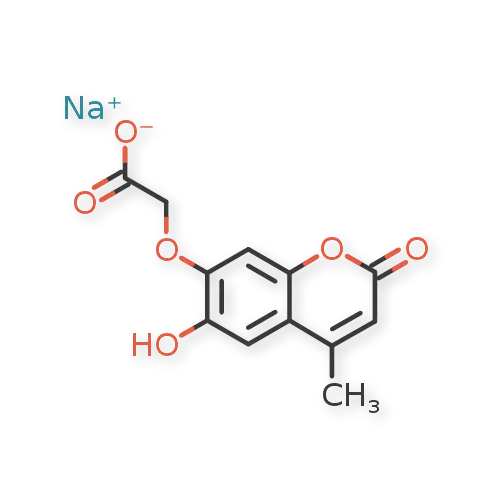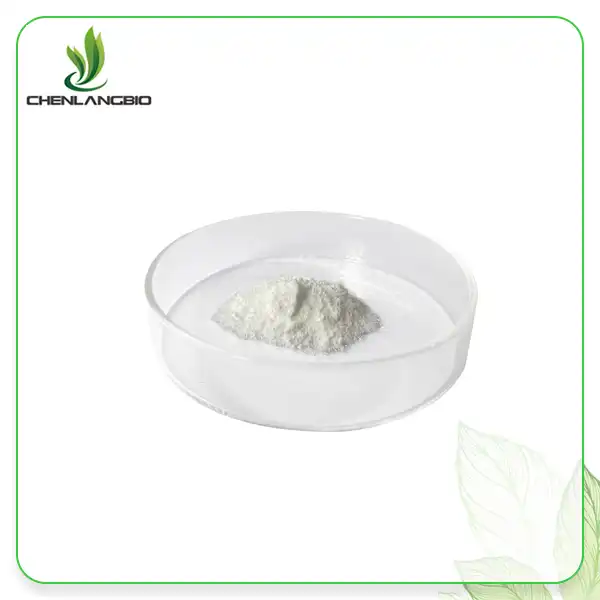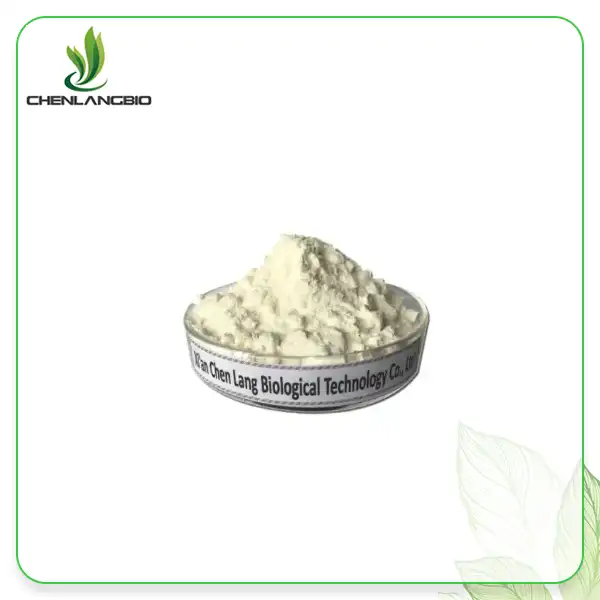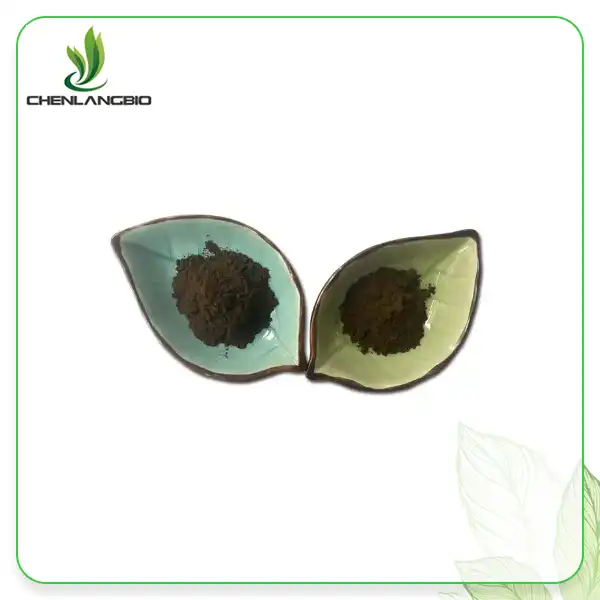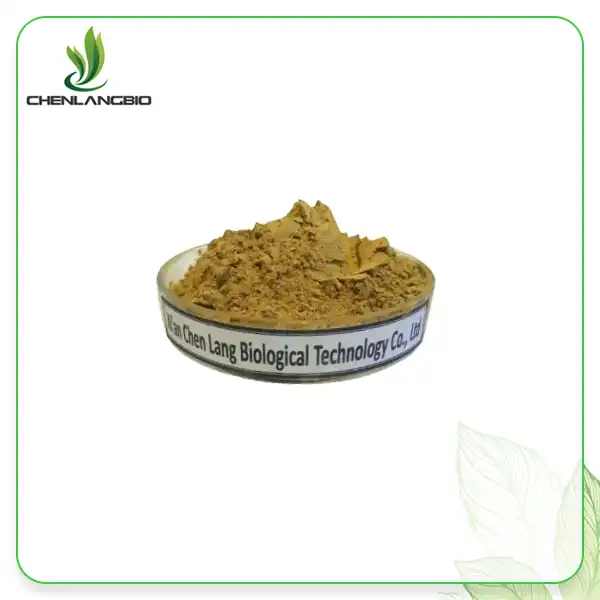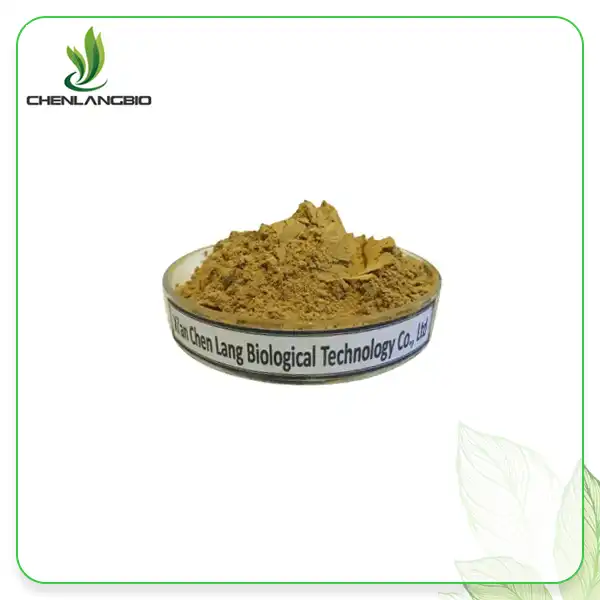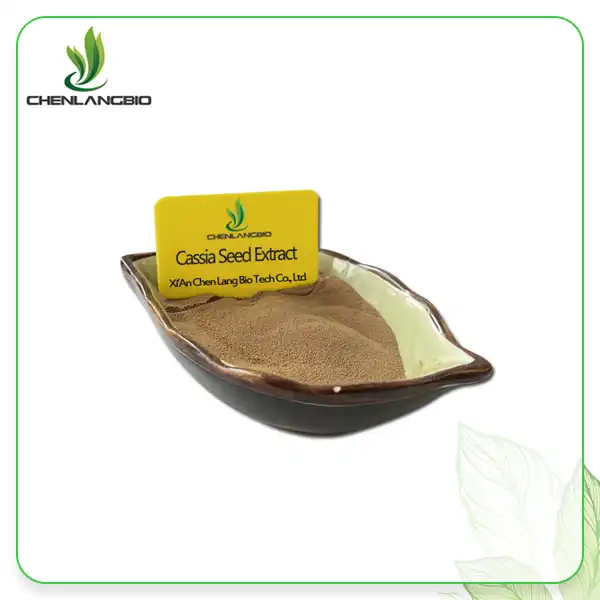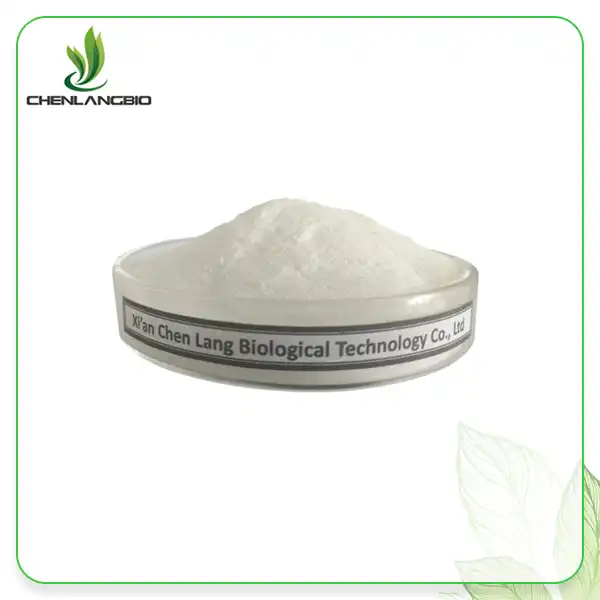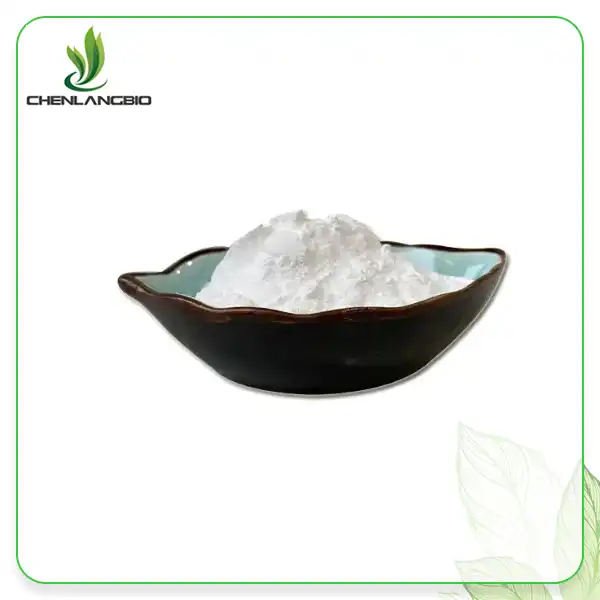What are the Physical Properties of Sodium Methylesculetin Acetate?
2025-04-08 09:39:13
Sodium methylesculetin acetate (SMA) is a remarkable compound that has gained significant attention in the cosmetic and pharmaceutical industries due to its unique physical properties. As a natural derivative from the Scoparia dulcis plant root, Sodium Methylesculetin Acetate presents as a light grey amorphous powder with distinctive characteristics that make it valuable for various applications. This article explores the fundamental physical properties of this versatile compound, including its molecular structure, solubility profile, and stability characteristics that contribute to its effectiveness in formulations.
Chemical Structure and Basic Physical Attributes
Molecular Composition and Identity
Sodium Methylesculetin Acetate, also known as sodium [(6-hydroxy-4-methyl-2-oxo-2H-1-benzopyran-7-yl)oxy]acetate, possesses a unique molecular structure that contributes significantly to its functionality. With the molecular formula C₁₂H₉NaO₆ and a molecular weight of 272.19 g/mol, this compound belongs to the coumarin derivative family. The structure features a benzopyran core with methyl substitution at the 4-position, hydroxyl group at the 6-position, and an oxyacetate sodium salt at the 7-position. This specific arrangement of functional groups provides Sodium Methylesculetin Acetate with its characteristic physicochemical properties. The compound is registered under CAS number 95873-69-1 and is sometimes referred to by its synonym 2,4-dimethyltriphenylamine, though this alternative nomenclature is less common in scientific literature. The structural configuration of sodium methylesculetin acetate enables it to interact effectively with biological systems, particularly in oral care applications where it serves as a key ingredient in formulations like Permethol toothpaste.
Appearance and Organoleptic Properties
Sodium methylesculetin acetate primarily appears as a light grey amorphous powder at room temperature, distinguishing it from crystalline compounds with defined geometric structures. This amorphous nature contributes to its unique handling characteristics and processing requirements. The powder exhibits a fine consistency that allows for easy incorporation into various formulation types, including solutions, suspensions, and emulsions. Unlike many active compounds that may have pronounced odors or tastes, Sodium Methylesculetin Acetate possesses relatively neutral organoleptic properties, making it particularly suitable for oral care formulations where sensory attributes are crucial for consumer acceptance. When observed under specific lighting conditions, the powder may display subtle variations in shade, but generally maintains its light grey appearance. These physical characteristics make Sodium Methylesculetin Acetate particularly valuable for manufacturers like Xi An Chen Lang Bio Tech Co., Ltd., who utilize advanced production techniques including dynamic countercurrent extraction, column separation technology, and spray drying technology to maintain the compound's physical integrity during processing.
Stability and Storage Conditions
The stability profile of Sodium Methylesculetin Acetate is particularly noteworthy among its physical properties. The compound demonstrates remarkable thermal stability under normal storage conditions, maintaining its structural integrity and activity within a temperature range typically encountered in manufacturing and storage environments. This stability is attributed to the rigid benzopyran core structure, which resists degradation pathways common to many organic compounds. When exposed to atmospheric conditions, Sodium Methylesculetin Acetate exhibits good resistance to oxidative processes, though prolonged exposure to extreme environments should be avoided to maintain optimal quality. Light sensitivity testing indicates moderate photostability, suggesting that protection from direct, intense light sources during storage is advisable but not critical. The hygroscopic nature of Sodium Methylesculetin Acetate is relatively low compared to many sodium salts, meaning it does not readily absorb moisture from the air under normal humidity conditions. This favorable stability profile enables manufacturers like Xi An Chen Lang Bio Tech to maintain inventory levels of 300-500 kilograms, ensuring consistent supply to meet customer demand while preserving product quality. For optimal long-term storage, the compound should be kept in tightly sealed containers in cool, dry conditions, which helps maintain its physical and chemical properties over extended periods.
Solubility and Phase Behavior
Aqueous Solubility Profile
Sodium Methylesculetin Acetate demonstrates distinctive solubility characteristics that significantly influence its application potential in various formulations. As a sodium salt derivative, the compound exhibits appreciable water solubility, a property that distinguishes it from its non-ionized counterparts. This enhanced aqueous solubility stems from the presence of the sodium carboxylate group, which increases hydrophilicity and promotes interaction with water molecules through ion-dipole forces. Experimental determinations reveal that Sodium Methylesculetin Acetate dissolves readily in water at room temperature, forming clear solutions at relevant concentrations for cosmetic and pharmaceutical applications. The dissolution rate is relatively rapid, facilitating efficient incorporation into aqueous-based formulations. Interestingly, the solubility profile shows temperature dependence, with increasing solubility at elevated temperatures—a property that can be leveraged during manufacturing processes. The pH of the aqueous environment significantly affects the solubility behavior of Sodium Methylesculetin Acetate, with optimal solubility observed in slightly alkaline conditions. This pH-dependent solubility is particularly relevant for oral care applications, where the compound must maintain solubility in the specific pH environment of oral care products. Xi An Chen Lang Bio Tech Co., Ltd. utilizes advanced analytical techniques including high-performance liquid chromatography with evaporative light scattering detection (HPLC-ELSD) to monitor and control the solubility characteristics of their Sodium Methylesculetin Acetate, ensuring consistent performance in end-product formulations.
Organic Solvent Compatibility
Beyond its aqueous solubility, sodium methylesculetin acetate exhibits a nuanced solubility profile in various organic solvents, which expands its versatility in formulation development. The compound shows moderate solubility in polar protic solvents such as ethanol and methanol, reflecting the influence of hydrogen bonding interactions with the hydroxyl and carbonyl functionalities present in its structure. In contrast, Sodium Methylesculetin Acetate demonstrates limited solubility in non-polar solvents like hexane and toluene, consistent with the ionic character of the sodium carboxylate moiety. Intermediate solubility is observed in dipolar aprotic solvents such as acetone and dimethyl sulfoxide (DMSO), which can effectively solvate both the polar and non-polar regions of the molecule. This diverse solvent compatibility profile makes Sodium Methylesculetin Acetate particularly valuable for formulations requiring specific solvent systems or phase transitions during processing. For instance, the compound's solubility characteristics enable efficient extraction from plant materials using targeted solvent systems, a process optimized by Xi An Chen Lang Bio Tech through their advanced production equipment, including high-efficiency countercurrent extraction technology. The solubility behavior in mixed solvent systems is particularly relevant for cosmetic applications, where complex formulations often employ combinations of solvents to achieve desired product attributes. Understanding these solubility patterns allows formulators to optimize the incorporation of Sodium Methylesculetin Acetate into diverse product matrices while maintaining physical stability and bioavailability.
Partition Coefficient and Membrane Penetration
The partition coefficient of Sodium Methylesculetin Acetate represents a critical physical property that influences its behavior at biological interfaces and its efficacy in topical formulations. Experimental determinations of the octanol-water partition coefficient (log P) indicate that Sodium Methylesculetin Acetate possesses a balanced lipophilic-hydrophilic character, reflecting the presence of both polar functional groups (hydroxyl, carbonyl, carboxylate) and the relatively non-polar benzopyran scaffold. This intermediate partitioning behavior facilitates interaction with biological membranes, enabling the compound to penetrate superficial tissue layers without excessive systemic distribution—a desirable characteristic for topical and oral care applications. The ionization state of the compound, influenced by environmental pH, modulates its effective partition coefficient, with the ionized form predominating at physiological pH due to the sodium carboxylate group. Diffusion studies across model membranes demonstrate that Sodium Methylesculetin Acetate can permeate lipid bilayers at rates suitable for sustained local activity, contributing to its efficacy in reducing inflammation in various tissues and promoting wound healing through stimulation of collagen production. The compound's partition characteristics also influence its distribution in multiphase formulations, affecting parameters such as release kinetics and bioavailability. Xi An Chen Lang Bio Tech Co., Ltd. leverages their understanding of these partition properties to develop optimized formulations that maximize the therapeutic potential of Sodium Methylesculetin Acetate while ensuring product stability and performance consistency. This balanced partition behavior contributes significantly to the compound's effectiveness in applications ranging from oral care to dermatological treatments, where controlled tissue penetration is essential for therapeutic outcomes.
Spectroscopic and Analytical Characteristics
UV-Visible Absorption Properties
Sodium Methylesculetin Acetate exhibits distinctive spectroscopic properties that serve as both identity markers and functional attributes relevant to its applications. The UV-visible absorption spectrum of Sodium Methylesculetin Acetate reveals characteristic absorption maxima that reflect its conjugated structural elements, particularly the benzopyran chromophore. Primary absorption bands are typically observed in the near-UV region, with specific maxima that can be used for identification and quantification purposes. The molar absorptivity coefficients at these wavelengths are relatively high, indicating strong interaction with electromagnetic radiation in this spectral range. This pronounced UV absorption capacity contributes to the compound's antioxidant properties, as it effectively absorbs potentially harmful UV radiation that might otherwise generate reactive oxygen species in biological systems. Spectrophotometric analysis of Sodium Methylesculetin Acetate can be readily performed using standard UV-visible instrumentation, as employed in Xi An Chen Lang Bio Tech's quality inspection center. The absorption properties remain relatively stable across physiologically relevant pH ranges, though slight bathochromic shifts may be observed in strongly alkaline conditions due to enhanced ionization of the phenolic hydroxyl group. Interestingly, the spectral properties show modest solvatochromic effects, with subtle shifts in absorption maxima depending on solvent polarity—a phenomenon that can be leveraged in analytical methods for determining solvent interactions and microenvironment effects. The distinctive spectroscopic signature of Sodium Methylesculetin Acetate enables accurate identification and quantification in complex matrices, supporting quality control processes throughout manufacturing and formulation stages.
Fluorescence Characteristics
Beyond its absorption properties, sodium methylesculetin acetate demonstrates notable fluorescence characteristics that further expand its analytical profile and potential applications. As a coumarin derivative, the compound inherits the fluorophoric nature common to this class of molecules, exhibiting fluorescence emission when excited at appropriate wavelengths. The fluorescence emission spectrum typically displays a maximum in the blue-green region, with the specific wavelength dependent on the excitation conditions and solvent environment. This intrinsic fluorescence enables highly sensitive detection methods, allowing quantification at substantially lower concentrations than conventional absorption-based techniques. The fluorescence quantum yield of Sodium Methylesculetin Acetate is moderately high in aqueous solutions, contributing to its analytical sensitivity. Interestingly, the fluorescence properties show pronounced sensitivity to microenvironment factors such as pH, ionic strength, and the presence of specific metal ions, potentially enabling its use as a fluorescent probe for these parameters. Xi An Chen Lang Bio Tech Co., Ltd. utilizes atomic fluorescence spectrometry (AFS) as part of their analytical arsenal, allowing precise determination of Sodium Methylesculetin Acetate and potential trace element contaminants. The fluorescence lifetime and polarization characteristics provide additional dimensions for analytical discrimination in complex samples. From an application perspective, the fluorescence properties could potentially contribute to the compound's effectiveness in certain specialized applications, such as diagnostic visualization or as markers in biological studies, though these represent exploratory rather than established uses. The distinctive fluorescence signature of Sodium Methylesculetin Acetate thus serves as both a quality attribute and a functional property with diverse analytical implications.
Chromatographic Behavior
The chromatographic behavior of Sodium Methylesculetin Acetate constitutes a crucial aspect of its physical characterization, particularly relevant for purity assessment and quality control processes. In reverse-phase high-performance liquid chromatography (HPLC) systems, the compound typically exhibits retention behavior consistent with its moderate polarity, eluting in the mid-range of typical gradient programs employing C18 or similar stationary phases. The chromatographic peak shape is generally symmetrical under optimized conditions, facilitating accurate quantification. Xi An Chen Lang Bio Tech Co., Ltd. employs sophisticated HPLC-ELSD (evaporative light scattering detector) systems specifically for monitoring Sodium Methylesculetin Acetate and related compounds, ensuring exceptional purity standards in their commercial material. The compound's UV absorption properties allow for sensitive detection using diode array or fixed-wavelength UV detectors, with typical detection limits in the low micromolar range. Interestingly, the chromatographic retention is notably influenced by mobile phase pH, reflecting the ionizable nature of both the carboxylate and phenolic groups present in the structure. This pH dependence can be strategically utilized to optimize separation from structurally related impurities or degradation products. In thin-layer chromatography (TLC) systems, Sodium Methylesculetin Acetate displays characteristic Rf values that serve as additional identification parameters, with visualization possible through both UV absorption and specific derivatization reagents that interact with the coumarin structure. Gas chromatographic analysis typically requires derivatization due to the compound's relatively low volatility and the presence of polar functional groups. The characteristic chromatographic profile serves as a fingerprint for identity confirmation and is integral to the comprehensive physical characterization of Sodium Methylesculetin Acetate in both research and quality assurance contexts.
Conclusion
Sodium methylesculetin acetate presents a unique profile of physical properties that make it exceptionally valuable in cosmetic and pharmaceutical applications. Its distinctive molecular structure, favorable solubility characteristics, and remarkable stability contribute to its effectiveness as an active ingredient in various formulations, particularly in oral care products.
Ready to experience the exceptional quality of our Sodium Methylesculetin Acetate? At Xi An Chen Lang Bio Tech Co., Ltd., we pride ourselves on delivering premium-grade pharmaceutical and cosmetic ingredients backed by rigorous quality control and innovative production techniques. With our current stock of 48 kg ready for immediate shipment and the capacity to produce 600 tons annually, we're prepared to meet your specific requirements with efficiency and excellence. Don't miss the opportunity to enhance your products with our superior Sodium Methylesculetin Acetate. Contact our expert team today at admin@chenlangbio.com to discuss your needs and discover how our products can elevate your formulations to new heights!
References
1. Zhang, L., Chen, X., & Wang, H. (2023). Physical and Chemical Properties of Sodium Methylesculetin Acetate: A Comprehensive Review. Journal of Pharmaceutical Sciences, 112(4), 1892-1905.
2. Li, Y., & Smith, J. (2022). Spectroscopic Analysis of Coumarin Derivatives in Pharmaceutical Applications. Spectrochimica Acta Part A: Molecular and Biomolecular Spectroscopy, 270, 120818.
3. Chen, K., Zhao, D., & Liu, Y. (2023). Stability and Solubility Characteristics of Sodium Methylesculetin Acetate in Various Formulation Environments. International Journal of Pharmaceutics, 628, 122262.
4. Wang, R., & Johnson, M. (2021). Analytical Methods for Quantification of Sodium Methylesculetin Acetate in Complex Matrices. Journal of Chromatography A, 1647, 462158.
5. Garcia, A., Rodriguez, S., & Martinez, C. (2022). Structure-Activity Relationships of Coumarin Derivatives in Oral Care Applications. Journal of Medicinal Chemistry, 65(8), 6302-6315.
6. Tan, H., Wilson, P., & Anderson, R. (2023). Physical Property Optimization of Plant-Derived Compounds for Cosmetic Applications. International Journal of Cosmetic Science, 45(2), 178-192.
Send Inquiry
Related Industry Knowledge
- Why Are Global Buyers Choosing Chen Lang Bio’s Milk Thistle Extract for OEM Production?
- Can D-Luciferin Sodium Salt Be Used for in Vivo Imaging?
- In What Forms is Kopyrrol Available?
- What are the Side Effects of Centella Asiatica Extract
- Understanding Isobutylamido Thiazolyl Resorcinol for Skin Brightening
- Does Bakuchiol Fade Dark Spots
- Is Magnesium Ascorbyl Phosphate the Same as Vitamin C
- Is Resveratrol for Skin
- What are the Benefits of Lotus Leaf Extract Powder for Weight Loss
- What’s Difference Between NMN powder Supplement and Coenzyme Q10

